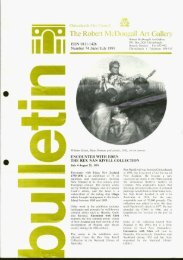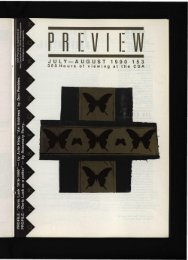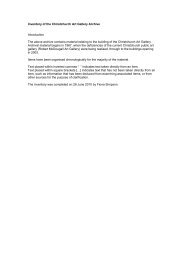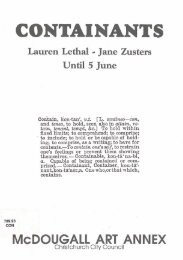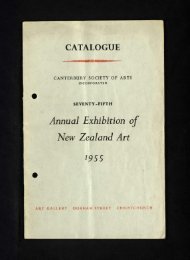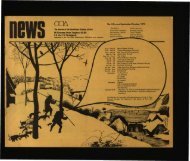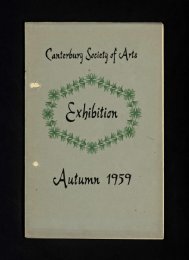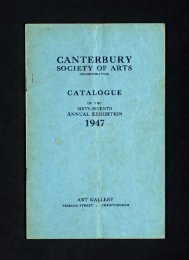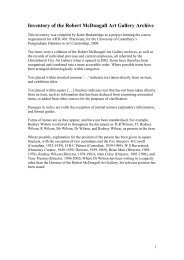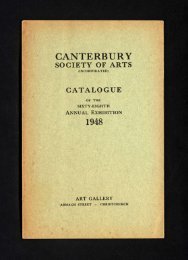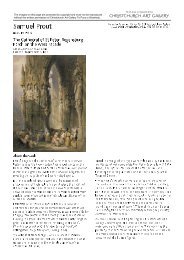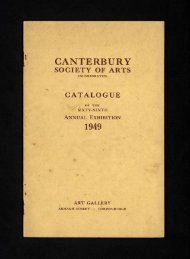Download - Christchurch Art Gallery
Download - Christchurch Art Gallery
Download - Christchurch Art Gallery
You also want an ePaper? Increase the reach of your titles
YUMPU automatically turns print PDFs into web optimized ePapers that Google loves.
The Dealer's Galleries that left a strong impression<br />
were often ones that exhibited work by artists he was<br />
surprised but pleased to see together, such as work by<br />
Egon Schiele with his intensely expressionistic and<br />
often erotic style, and Henry Matisse, with his calm,<br />
classically spare line, and untroubled subject matter,<br />
but both artists sharing a superbly elegant way with<br />
drawing.<br />
The exhibition of works by Mondrian and Brancusi at<br />
the Sidney Janus <strong>Gallery</strong> was another combination of<br />
artists Don found rewarding.<br />
The Guggenheim Museum showed an exhibition of<br />
Yves Klein — a precursor of much modern art, and<br />
Don was most impressed by a work painted in the<br />
famous and patented International Klein Blue, which<br />
he thought magnificent, radiating light.<br />
The artists Don met included Max Gimlet and Bill<br />
Alpert with whose work he felt a great empathy; and<br />
Peter Wareing, a recent Canterbury Honours student<br />
working in a neo-expressionist style. Gretchen<br />
Albrecht was also working in New York and on her<br />
introduction he visited the Exeter Press where she was<br />
working on hand-made paper.<br />
Don was moved by the commitment to work and<br />
seriousness of so many of the artists in New York.<br />
It was interesting to observe how artists were influenced<br />
by their environment, and the response which<br />
was seen in their work.<br />
Don said that of the new art being produced, two<br />
tendencies were strongly apparent — one being in<br />
exploring an aspect of abstraction where the artists<br />
share the belief that by eliminating the traditional pictorial<br />
devices of realism and figurative references, they<br />
can explore paint with more emotive force; and the<br />
other being a neo-expressionist type of painting which<br />
has emerged as a broad phenonomen.<br />
Not all the New Image work was abstract. There<br />
seemed to be a return to some figurative or narrative<br />
imagery, but one thing was common to all which was a<br />
concern for the way in which the paint was applied.<br />
There was a trend towards a return to oil paint.<br />
The impression felt most powerfully was that New<br />
York was a city of contrasts; from the neighbourhood<br />
or street artist to the Museum of Modern <strong>Art</strong>; from<br />
galleries filled with works to another exhibiting only<br />
one work; the contrast of modern and historic architecture;<br />
from street music by day to a syncopated jazz<br />
rhythm by night; the contrast of people moving about<br />
the city, to sculptural works, particularly those of Charles<br />
Simmonds who sculpts small dwellings for an<br />
imaginary civilisation of "Little People". These are<br />
often placed in unexpected situations so they are protected<br />
from thoughtless acts by larger people.<br />
During his talk Don repeatedly referred to the graffiti<br />
around the city — particularly on the subway, inside<br />
and outside the trains were covered in it; on trucks, the<br />
sides of buildings, in doorways, on billboards — all<br />
very lively and colourful splashes on multifarious surfaces<br />
with a wealth of imagery — perhaps, as one New<br />
York writer claims, the new art, but certainly with an<br />
exciting awareness of a very human presence in it.<br />
Don mentioned the worth of exploring both good and<br />
bad art, in that the good confirms our theories, while<br />
the bad may expand our ideas.<br />
<strong>Art</strong>ists are fortunate now, he said, in that they have<br />
freedom to explore without the constraints that were<br />
imposed (by institutions) as in the 50s and 60s.<br />
By day and night New York proved to be a most<br />
stimulating city and Don could see how people like<br />
Mondrian were inspired. Although it has a population<br />
of 10 million people, which was cramped, he did not<br />
feel claustrophobic because the eye was able to<br />
explore spaces up and down with their multitudinous<br />
features.<br />
This talk was organised by the Friends of the<br />
McDougall <strong>Gallery</strong>, charging an entry fee of $1.50<br />
which goes into an acquisition fund. Talks are held<br />
monthly.<br />
jfrush n-palelfj<br />
BELLS ARCADE<br />
CASHEL STREET<br />
Available<br />
arlisTs<br />
supplies<br />
\<br />
John Rooney<br />
Phone 63-088<br />
at<br />
G.B.D. PRINTS LTD<br />
207 Cashel St. (Opp; The Farmers)<br />
Telephone 60 033<br />
A comprehensive range of artists' materials:<br />
Acrylic, oil & water colours, brushes, papers,<br />
drawing blocks, easels, mounting boards and art<br />
accessories.<br />
SEVERAL ARTS<br />
807 COLOMBO STREET, CHRISTCHURCH<br />
TELEPHONE 69-264<br />
GALLERY FOR EXHIBITIONS<br />
WEAVING AND SPINNING SUPPLIES<br />
HOME Of FINEST POTTERY<br />
SHIRLEY and GRAHAM INWOOD



